If you are working in India, you have probably heard from your colleagues talking about CL, SL, and PL. Some people use them wisely, others lose them by year-end without realizing their value.
But here’s the thing — leaves are not just “days off.” They are a right you earn, a balance you manage, and in some cases, even a small financial bonus if you don’t use them in terms of leave encashment.

Casual Leave (CL)
Casual Leave is meant for short-term, sudden, or urgent needs. It’s like a “quick escape” button when something unexpected comes up.
Most companies in India provide 7–12 days of CL per year, though the exact number depends on your state’s Shops and Establishment Act or your company’s internal policy.
- Purpose: Urgent personal work, family emergencies, short travels.
- Notice: You can inform on the same day or a day before — but if possible, always give advance notice.
- Carry forward: No — if you don’t use them, they expire at year-end.
- Encashment: Not allowed.
Ravi works in Mumbai and has 2 days of CL left in December. One morning, his gas connection develops a leak, and the gas company can send a technician only during office hours. He applies for a Casual Leave to stay home and supervise the repair. No long explanations, no medical certificate — just a quick approval and he’s sorted.
Sick Leave (SL)
Sick Leave is your right to take time off when you are ill, injured, or recovering from a medical procedure.
The usual allowance is 6–15 days per year, though it varies. Some companies provide separate SL, others combine it with CL under a single category called “Casual/Sick Leave.”
- Purpose: Fever, flu, injury, recovery from minor surgery, or any other health issue.
- Notice: Ideally inform your manager as soon as possible — even if it’s early morning on the day of absence.
- Proof: If you take more than 2–3 days at a stretch, you may need to submit a medical certificate.
- Carry forward: Sometimes yes, sometimes no — depends on the employer’s policy.
- Encashment: Rare
Priya works in an IT company in Bengaluru. She wakes up with high fever and body ache on Monday. She immediately sends an email to her team lead saying she’s on Sick Leave for 2 days. By Wednesday, she’s feeling better but still weak, so she extends it by one more day and shares her doctor’s prescription with HR.
Privilege Leave (PL)
Privilege Leave — also called Earned Leave (EL) or Paid Leave — is for planned vacations, personal commitments, or long breaks. The word “privilege” is used because you earn these leaves over time, usually at the rate of 1 to 1.5 days per month of service.
Most companies grant between 15–30 days of PL per year. This type of leave can usually be carried forward to the next year, up to a limit (often 30–45 days). Many companies also pay you for unused PL when you resign this is called leave encashment.
- Purpose: Planned travel, weddings, long family functions, extended rest.
- Notice: Advance notice (often 7–15 days) is required.
- Carry forward: Yes, within limits.
- Encashment: Yes, in most cases.
Neha has been working for 3 years and has 20 PL left. She plans a trip to Kashmir in December and applies for 10 days of PL a month in advance. HR approves it, and she enjoys her trip without worrying about salary deductions.

